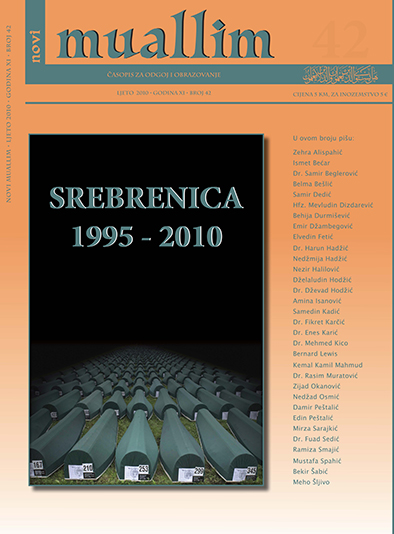RELATIONSHIP TO PAST REGARDING BOSNIAK UNDERSTANDING OF ISLAM IN 20TH CENTURY
DOI:
https://doi.org/10.26340/muallim.v11i42.769Abstract
In this paper, the author first explores and sets forth the importance and significance of the frame of space and time as two inseparables within which all the events in history emerge, develop and vanish. All religions and cultures strive to have the knowledge and remembrance of history. The author points out three basic dimensions of Islamic comprehension of history. The first dimension of history is represented by the God’s Messages and Testimonies about the Messengers. The task and objective of the second dimension of history is to tell of true and actual events. Finally, the third dimension of history, the so-called Tarih, determines a precise sequence and order of historical events. According to the author, the essence of history in Islam is that a man fulfils his mission as a God’s Vicegerent and Creditor on earth. The author also critically examines the content of the published works of the 20th century Bosniak publicists, mainly consisting of translations, descriptions, syncretism, panegyrics and compilations. The most significant success of the Islamic Community in 20th century is, according to the author, the opening of the Faculty of Islamic Theology/ Studies in Sarajevo in 1977, and as for the political and governmental life of the state, it is the international recognition and defence of Bosnia and Herzegovina and the Bosniak defence against extermination of in the period between 1990 and 1996.
Downloads
Published
How to Cite
Issue
Section
License
Naknada:
a. Časopis ne naplaćuje naknadu za obradu članaka (APC) i naknadu za podnošenje članaka.
Autori koji objavljuju u ovom časopisu pristaju na sljedeće uvijete:
- Autori zadržavaju autorska prava i pružaju časopisu pravo prvog objavljivanja, pri čemu će rad jednu godinu po objavljivanju biti podložan licenci Creative Commons imenovanje koja omogućuje drugima da dijele rad uz uvijet navođenja autorstva i izvornog objavljivanja u ovom časopisu.
- Autori mogu izraditi zasebne, ugovorne aranžmane za ne-ekskluzivnu distribuciju rada objavljenog u časopisu (npr. postavljanje u institucionalni repozitorij ili objavljivanje u knjizi), uz navođenje da je rad izvorno objavljen u ovom časopisu.


